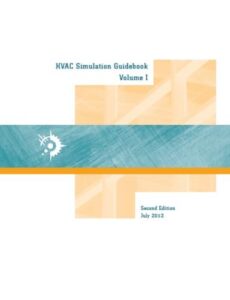HVAC Simulation Guidebook Volume 1
HVAC Simulation Guidebook Volume 1
HVAC Simulation Guidebook Volume 1 is concerned with methods for analyzing air distribution systems that deliver cooling and heating air at floor level instead of from the ceiling. An example of such a system is underfloor air distribution (UFAD), where conditioned air is delivered at a moderate velocity (650 to 800 feet-per-minute) via a 10” to 16” plenum space underneath an access floor system (Figure 1a). Another example is a Thermal Displacement Ventilation (TDV) system that delivers supply air horizontally at low velocity (50 to 100 feet-per-minute) from wall-mounted diffusers without using an underfloor plenum.
Underfloor air distribution (UFAD) and thermal displacement ventilation (TDV) have become increasingly common in commercial new construction because they are energy efficient, enhance indoor air quality, and increase flexibility for space reconfiguration. However, conflicting opinions exist concerning the benefits of UFAD and TDV.
You can also Read Solar Cells: Materials, Manufacture and Operation
HVAC Simulation Guidebook Volume 1 Content
- Underfloor Air Distribution and Thermal Displacement Ventilation
![HVAC Simulation Guidebook Volume 1]()
- Energy Efficient Chillers
- How Chiller Performance is Specified in DOE-2
- Improved Models for Variable Speed Chillers in DOE-2.2.
- Data Required for Specifying Chiller Performance Curves in Doe-2.
- Obtaining Data Required for Chiller Performance Curves
- Methods for Creating Custom DOE-2 Chiller Models
- Methods for Including Chiller Data in DOE-2 Performance Curves
- Advanced Control Sequences
- Variable Speed Drive Control Sequences
- Condenser Water System Operation
- Chilled Water Loop Temperature Reset
- Hot Water Loop Temperature Reset
This often leads to inappropriate analysis and unrealistic customer expectations. There are many different notions regarding the energy efficiency of UFAD and TDV systems, with some people claiming that these systems save little or no energy, while others suggest that they can cut HVAC energy usage by fifty percent or more. To help the energy modeler evaluate the energy benefits of UFAD and TDV, this simulation guidebook identifies the key characteristics that distinguish UFAD and TDV systems from traditional overhead systems and presents a logical, engineering-based method for analyzing UFAD and TDV with DOE-2-based simulation programs.


Comments are closed.